Paper Menu >>
Journal Menu >>
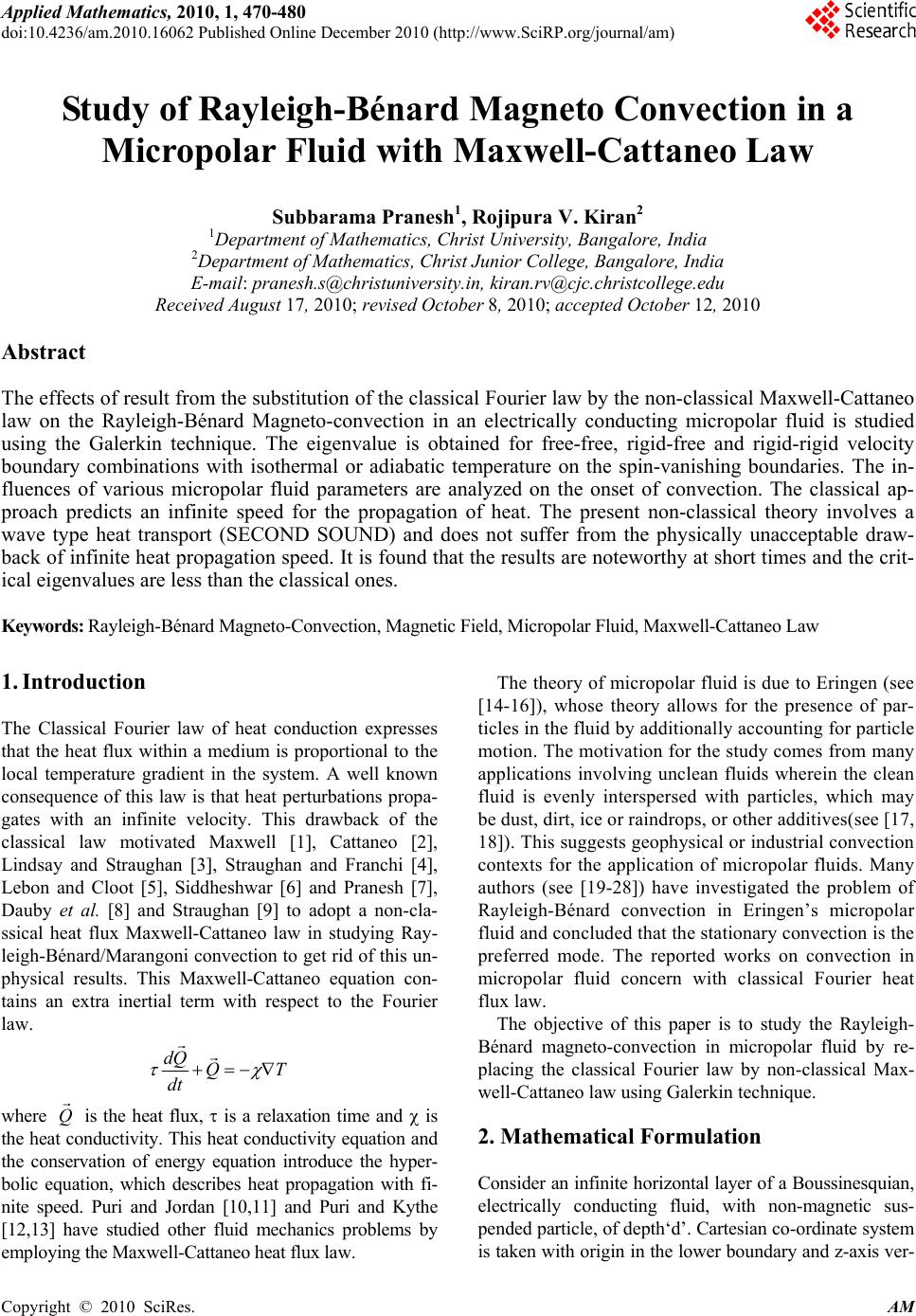 Applied Mathematics, 2010, 1, 470-480 doi:10.4236/am.2010.16062 Published Online December 2010 (http://www.SciRP.org/journal/am) Copyright © 2010 SciRes. AM Study of Rayleigh-Bénard Magneto Convection in a Micropolar Fluid with Maxwell-Cattaneo Law Subbarama Pranesh1, Rojipura V. Kiran2 1Department of Mathematics, Christ University, Bangalore, India 2Department of Mathematics, Christ Junior College, Bangalore, India E-mail: pranesh.s@christuniversity.in , kiran.rv@cjc.christcollege.edu Received August 17, 2010; revised October 8, 2010; accepted October 12, 2010 Abstract The effects of result from the substitution of the classical Fourier law by the non-classical Maxwell-Cattaneo law on the Rayleigh-Bénard Magneto-convection in an electrically conducting micropolar fluid is studied using the Galerkin technique. The eigenvalue is obtained for free-free, rigid-free and rigid-rigid velocity boundary combinations with isothermal or adiabatic temperature on the spin-vanishing boundaries. The in- fluences of various micropolar fluid parameters are analyzed on the onset of convection. The classical ap- proach predicts an infinite speed for the propagation of heat. The present non-classical theory involves a wave type heat transport (SECOND SOUND) and does not suffer from the physically unacceptable draw- back of infinite heat propagation speed. It is found that the results are noteworthy at short times and the crit- ical eigenvalues are less than the classical ones. Keywords: Rayleigh-Bénard Magneto-Convection, Magnetic Field, Micropolar Fluid, Maxwell-Cattaneo Law 1. Introduction The Classical Fourier law of heat conduction expresses that the heat flux within a medium is proportional to the local temperature gradient in the system. A well known consequence of this law is that heat perturbations propa- gates with an infinite velocity. This drawback of the classical law motivated Maxwell [1], Cattaneo [2], Lindsay and Straughan [3], Straughan and Franchi [4], Lebon and Cloot [5], Siddheshwar [6] and Pranesh [7], Dauby et al. [8] and Straughan [9] to adopt a non-cla- ssical heat flux Maxwell-Cattaneo law in studying Ray- leigh-Bénard/Marangoni convection to get rid of this un- physical results. This Maxwell-Cattaneo equation con- tains an extra inertial term with respect to the Fourier law. TQ dt Qd where Q is the heat flux, is a relaxation time and is the heat conductivity. This heat conductivity equation and the conservation of energy equation introduce the hyper- bolic equation, which describes heat propagation with fi- nite speed. Puri and Jordan [10,11] and Puri and Kythe [12,13] have studied other fluid mechanics problems by employing the Maxwell-Cattaneo heat flux law. The theory of micropolar fluid is due to Eringen (see [14-16]), whose theory allows for the presence of par- ticles in the fluid by additionally accounting for particle motion. The motivation for the study comes from many applications involving unclean fluids wherein the clean fluid is evenly interspersed with particles, which may be dust, dirt, ice or raindrops, or other additives(see [17, 18]). This suggests geophysical or industrial convection contexts for the application of micropolar fluids. Many authors (see [19-28]) have investigated the problem of Rayleigh-Bénard convection in Eringen’s micropolar fluid and concluded that the stationary convection is the preferred mode. The reported works on convection in micropolar fluid concern with classical Fourier heat flux law. The objective of this paper is to study the Rayleigh- Bénard magneto-convection in micropolar fluid by re- placing the classical Fourier law by non-classical Max- well-Cattaneo law using Galerkin technique. 2. Mathematical Formulation Consider an infinite horizontal layer of a Boussinesquian, electrically conducting fluid, with non-magnetic sus- pended particle, of depth‘d’. Cartesian co-ordinate system is taken with origin in the lower boundary and z-axis ver- 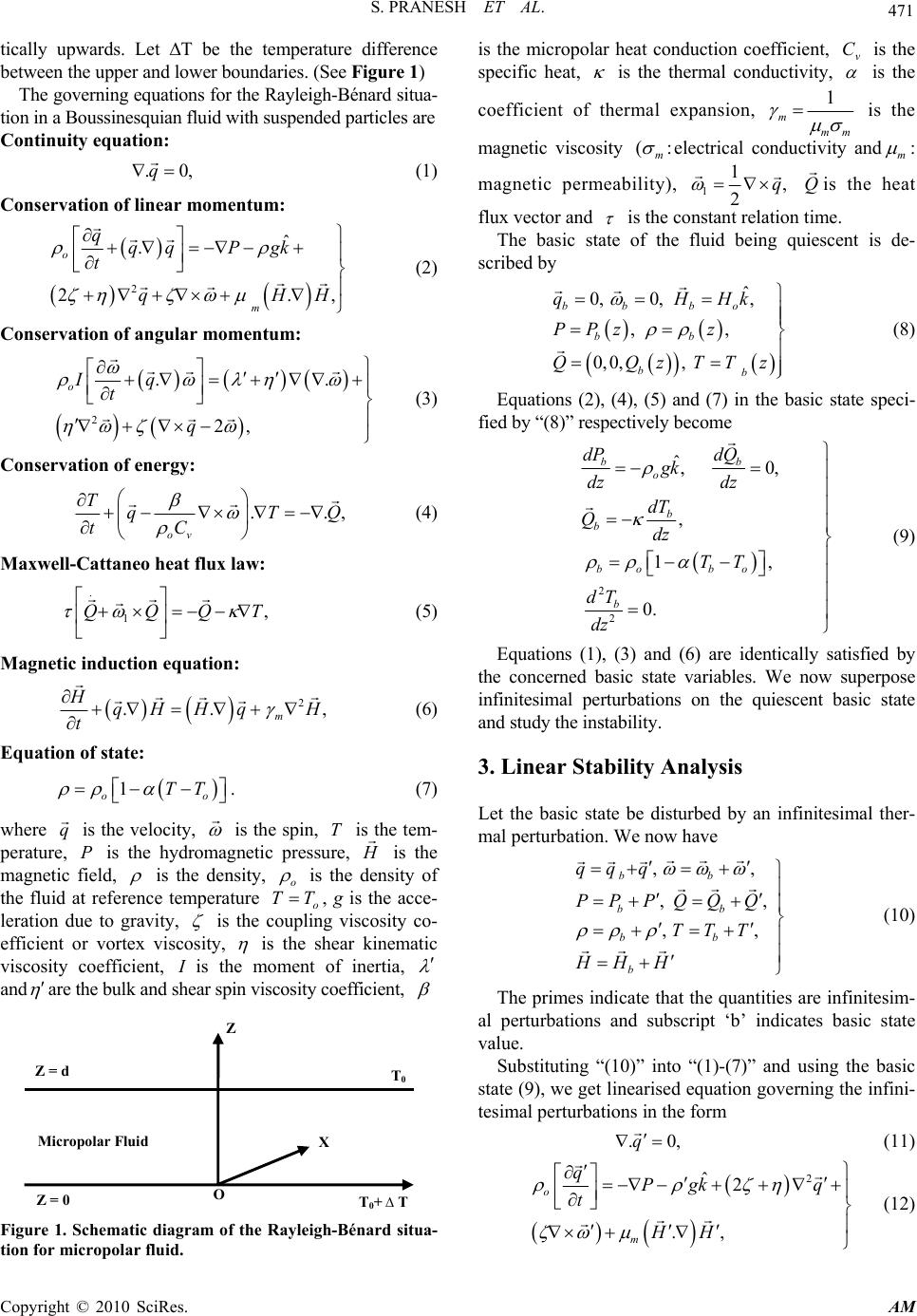 S. PRANESH ET AL. Copyright © 2010 SciRes. AM 471 tically upwards. Let T be the temperature difference between the upper and lower boundaries. (See Figure 1) The governing equations for the Rayleigh-Bénard situa- tion in a Boussinesquian fluid with suspended particles are Continuity equation: .0,q (1) Conservation of linear momentum: 2 ˆ . 2., o m qqqP gk t qHH (2) Conservation of angular momentum: 2 .. 2, oIq t q (3) Conservation of energy: .., ov TqTQ tC (4) Maxwell-Cattaneo heat flux law: . 1,QQQT (5) Magnetic induction equation: 2 .. , m HqHHq H t (6) Equation of state: 1 oo TT . (7) where q is the velocity, is the spin, T is the tem- perature, P is the hydromagnetic pressure, H is the magnetic field, is the density, o is the density of the fluid at reference temperature o TT , g is the acce- leration due to gravity, is the coupling viscosity co- efficient or vortex viscosity, is the shear kinematic viscosity coefficient, I is the moment of inertia, and are the bulk and shear spin viscosity coefficient, T 0 + T T 0 O X Z = d Z = 0 Micropol a r Fluid Z Figure 1. Schematic diagram of the Rayleigh-Bénard situa- tion for micropolar fluid. is the micropolar heat conduction coefficient, v C is the specific heat, is the thermal conductivity, is the coefficient of thermal expansion, mm m 1 is the magnetic viscosity :( m electrical conductivity andm : magnetic permeability), 1 1, 2qQ is the heat flux vector and is the constant relation time. The basic state of the fluid being quiescent is de- scribed by ˆ 0, 0,, ,, 0, 0,, bb bo bb bb qHHk PPz z QQzTTz (8) Equations (2), (4), (5) and (7) in the basic state speci- fied by “(8)” respectively become 2 2 ˆ,0, , 1, 0. bb o b b bo bo b dP dQ gk dz dz dT Qdz TT dT dz (9) Equations (1), (3) and (6) are identically satisfied by the concerned basic state variables. We now superpose infinitesimal perturbations on the quiescent basic state and study the instability. 3. Linear Stability Analysis Let the basic state be disturbed by an infinitesimal ther- mal perturbation. We now have ,, ,, ,, bb bb bb b qqq PPPQQQ TTT HH H (10) The primes indicate that the quantities are infinitesim- al perturbations and subscript ‘b’ indicates basic state value. Substituting “(10)” into “(1)-(7)” and using the basic state (9), we get linearised equation governing the infini- tesimal perturbations in the form ,0. q (11) 2 ˆ2 ., o m qPgk q t HH (12) 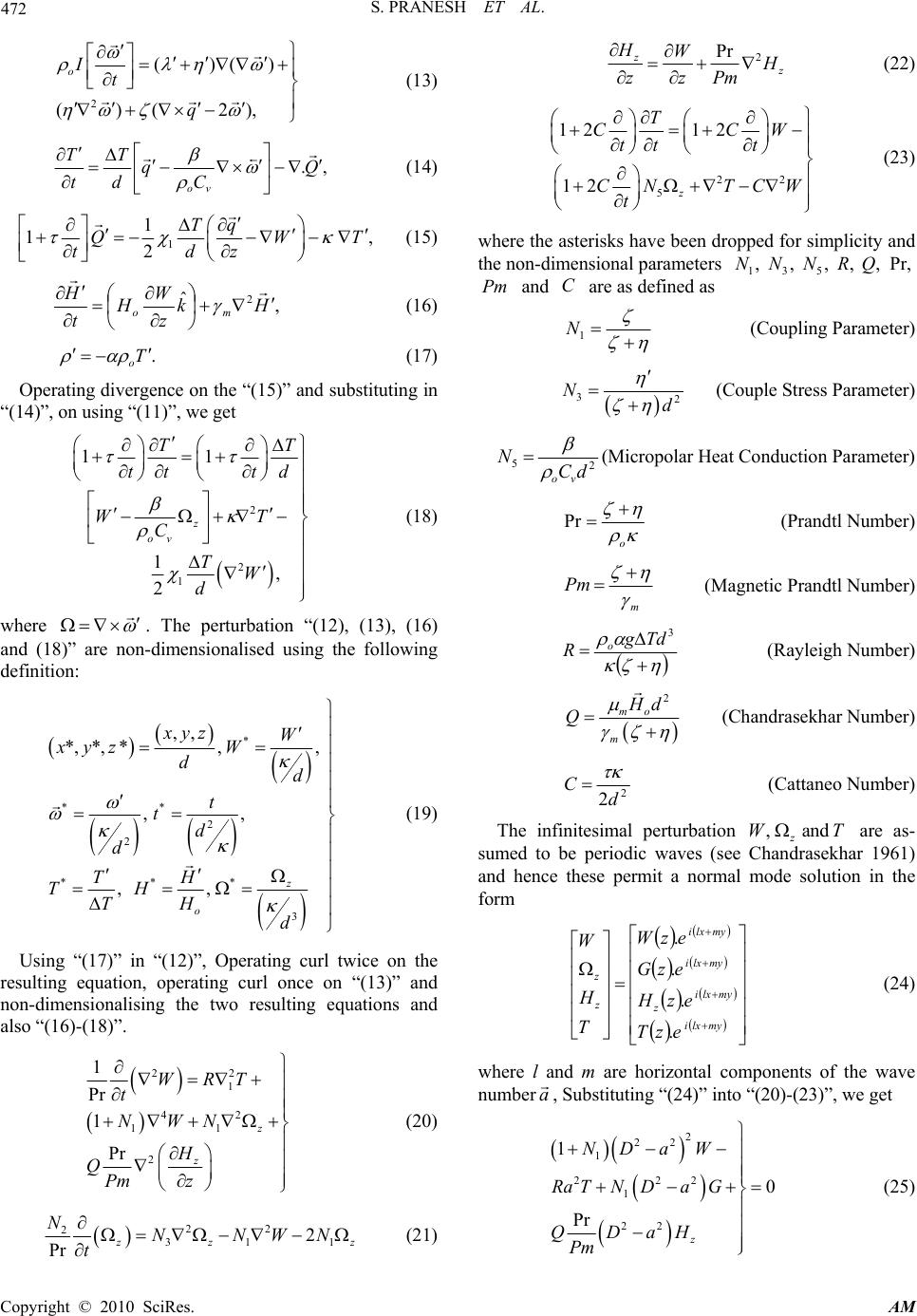 S. PRANESH ET AL. Copyright © 2010 SciRes. AM 472 2 ()() ()( 2), oIt q (13) ,.Q C q d T t T vo (14) 1 1 1, 2 Tq QWT tdz (15) , ˆ2Hk z W H t Hmo (16) .T o (17) Operating divergence on the “(15)” and substituting in “(14)”, on using “(11)”, we get 2 2 1 11 1, 2 z ov TT tt td WT C TW d (18) where . The perturbation “(12), (13), (16) and (18)” are non-dimensionalised using the following definition: * ** 2 2 *** 3 ,, *, *,*,, ,, ,, z o xyz W xyz W dd t td d TH TH TH d (19) Using “(17)” in “(12)”, Operating curl twice on the resulting equation, operating curl once on “(13)” and non-dimensionalising the two resulting equations and also “(16)-(18)”. 22 1 42 11 2 1 Pr 1 Pr z z WRT t NWN H QPm z (20) 22 2 31 1 2 Pr z zz NNNWN t (21) 2 Pr z z HW H zzPm (22) 22 5 12 12 12 z T CCW tt t CN TCW t (23) where the asterisks have been dropped for simplicity and the non-dimensional parameters 135 ,,,,,Pr,NNNRQ Pm and C are as defined as 1 N (Coupling Parameter) 32 Nd (Couple Stress Parameter) 2 5dC N vo (Micropolar Heat Conduction Parameter) Pr o (Prandtl Number) m Pm (Magnetic Prandtl Number) 3 Tdg Ro (Rayleigh Number) 2 mo m H d Q (Chandrasekhar Number) 2 2d C (Cattaneo Number) The infinitesimal perturbation ,and z WT are as- sumed to be periodic waves (see Chandrasekhar 1961) and hence these permit a normal mode solution in the form mylxi mylxi z mylxi mylxi z z ezT ezH ezG ezW T H W . . . . (24) where l and m are horizontal components of the wave number a , Substituting “(24)” into “(20)-(23)”, we get 2 22 1 222 1 22 1 0 Pr z NDaW Ra TNDaG QDaH Pm (25)  S. PRANESH ET AL. Copyright © 2010 SciRes. AM 473 22 3 22 11 0 2 ND aG ND aWNG (26) 22 Pr 0 z DWDa H Pm (27) 22 5 22 0 WNG DaT CDa W (28) where dz d D. The set of ordinary differential “(25)-(28)” are ap- proximations based on physical considerations to the sys- tem of partial differential “(20)-(23)”. Although the rela- tionship between the solutions of the governing partial differential equations and the corresponding ordinary dif- ferential equations has not been established, these linear models reproduce qualitatively the convective phenomena observable through the full system. Eliminating z H between “(25) and (27)”, we get 2 22 2 1 22 2 1 10 NDaWRaT ND aGQDW (29) We now apply the Galerkin method to “(26), (28) and (29)” that gives general results on the eigen value of the problem using simple, polynomial, trial functions for the lowest eigen value. We obtain an approximate solution of the differential equations with the given boundary conditions by choosing trial functions for velocity, mi- crorotation and temperature perturbations that satisfy the boundary conditions but may not exactly satisfy the dif- ferential equations. This leads to residuals when the trial functions are substituted into the differential equations. The Galerkin method requires the residual to be ortho- gonal to each individual trial function. In the Galerkin procedure, we expand the velocity, microrotation and temperature by, ,, ,, , ii ii ii Wzt AtWz GztBtG z Tzt EtTz where )()(),(zTandzGzW iii are polynomials in z that generally have to satisfy the given boundary conditions. For the single term Galerkin expansion technique we take i = j = 1. Multiplying “(29)” by W, “(26)” by G and “(28)” by T, integrating the resulting equation with re- spect to z from 0 to 1 and taking W = AW1, G = BG1 and T = ET1 in which A, B and E are constants with W1, G1 and T1 are trial functions. This procedure yields the fol- lowing equation for the Rayleigh number R: 22 2 111213 2 11 4 ..TDaT YYNY RaWTY (30) where 2 22 111 1 2 11 22 2 2311 11 22 22 3111 1 22 4151 111 22 21 111 1 , 2, , . YNWDaW QWDW YNGDaGNG Y GDaWWDaG YNNGDaWTG YCTD aWTW In the “(30)”, denotes integration with respect to z between 0 zand 1 z . We note here that R in equa- tion (30) is a functional and the Euler-Lagrange equa- tions for the extremisation of R are “(26), (28) and (29)”. The value of critical Rayleigh number depends on the boundaries. In this paper we consider various boundary combinations and these are discussed below. 1) Free – Free isothermal/adiabatic, no spin. 2) Rigid – Rigid isothermal/adiabatic, no spin. 3) Rigid – Free isothermal/adiabatic, no spin. Critical Rayleigh number for free-free isothermal boundaries , N o spi n: The boundary conditions are .1,0,0 2 zatGTWDW (31) The trial functions satisfying “(30)” are 43 1 1 1 2, 1, 1 Wz zz Tz z Gz z (32) Substituting “(32)” in “(30)” and performing the integra- tion, we get 2 1 2 51 10 a Ma R (33) where 22 21113 1 23 153 24 1 2 23 1 2 3 28.13063 ., .17 .. 3024 61231 , 102 , 168 17. K NKQ NK MKCKNNK Kaa KNa N Ka R attains its minimum value Rc at a = ac. Critical Rayleigh number for rigid-rigid isothermal boundaries , N o spi n: 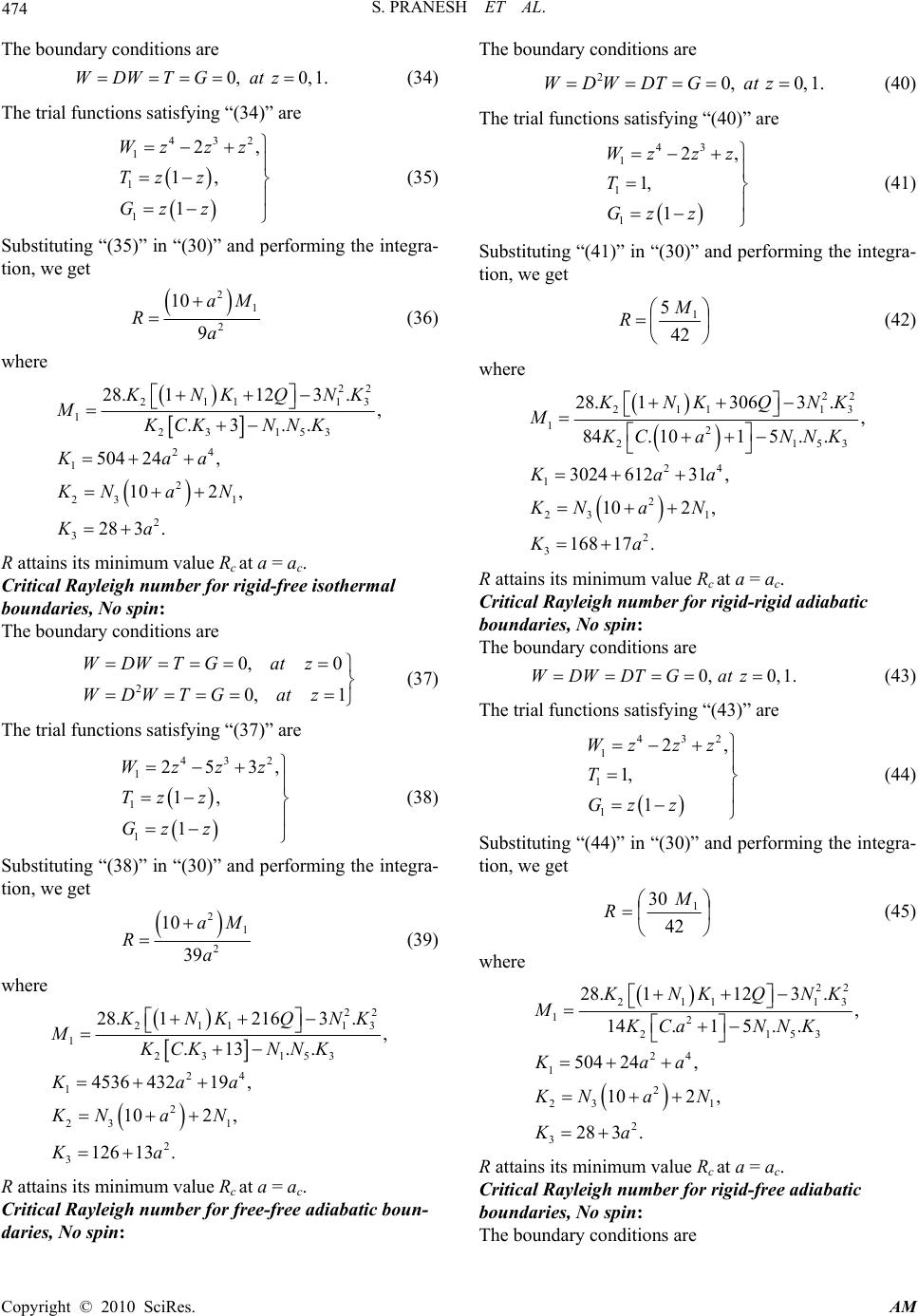 S. PRANESH ET AL. Copyright © 2010 SciRes. AM 474 The boundary conditions are .1,0,0 zatGTDWW (34) The trial functions satisfying “(34)” are 432 1 1 1 2, 1, 1 Wz zz Tz z Gz z (35) Substituting “(35)” in “(30)” and performing the integra- tion, we get 2 1 2 10 9 aM Ra (36) where 22 21113 1 23 153 24 1 2 23 1 2 3 28.1123 ., .3 .. 504 24, 102 , 28 3. K NKQNK MKCKNNK Kaa KNa N Ka R attains its minimum value Rc at a = ac. Critical Rayleigh number for rigid-free isothermal boundaries , N o spi n: The boundary conditions are 2 0, 0 0, 1 WDWTG atz WDWTGatz (37) The trial functions satisfying “(37)” are 432 1 1 1 253, 1, 1 Wzzz Tz z Gz z (38) Substituting “(38)” in “(30)” and performing the integra- tion, we get 2 1 2 10 39 aM Ra (39) where 22 21113 1 23 153 24 1 2 23 1 2 3 28.12163 ., .13 .. 4536 43219, 102 , 126 13. K NKQNK MKCKNNK Kaa KNa N Ka R attains its minimum value Rc at a = ac. Critical Rayleigh number for free-free adiabatic boun- daries, No spin : The boundary conditions are .1,0,0 2 zatGDTWDW (40) The trial functions satisfying “(40)” are 43 1 1 1 2, 1, 1 Wz zz T Gz z (41) Substituting “(41)” in “(30)” and performing the integra- tion, we get 42 51 M R (42) where 22 21113 12 2153 24 1 2 23 1 2 3 28.13063 ., 84.1015.. 3024 61231 , 102 , 168 17. K NKQ NK MKCaNNK Kaa KNa N Ka R attains its minimum value Rc at a = ac. Critical Rayleigh number for rigid-rigid adiabatic boundaries , N o spi n: The boundary conditions are .1,0,0 zatGDTDWW (43) The trial functions satisfying “(43)” are 432 1 1 1 2, 1, 1 Wz zz T Gz z (44) Substituting “(44)” in “(30)” and performing the integra- tion, we get 42 30 1 M R (45) where 22 211 13 12 2153 24 1 2 23 1 2 3 28.1123 ., 14.15 .. 504 24, 102 , 28 3. K NKQ NK MKCa NNK Kaa KNa N Ka R attains its minimum value Rc at a = ac. Critical Rayleigh number for rigid-free adiabatic boundaries , N o spi n: The boundary conditions are 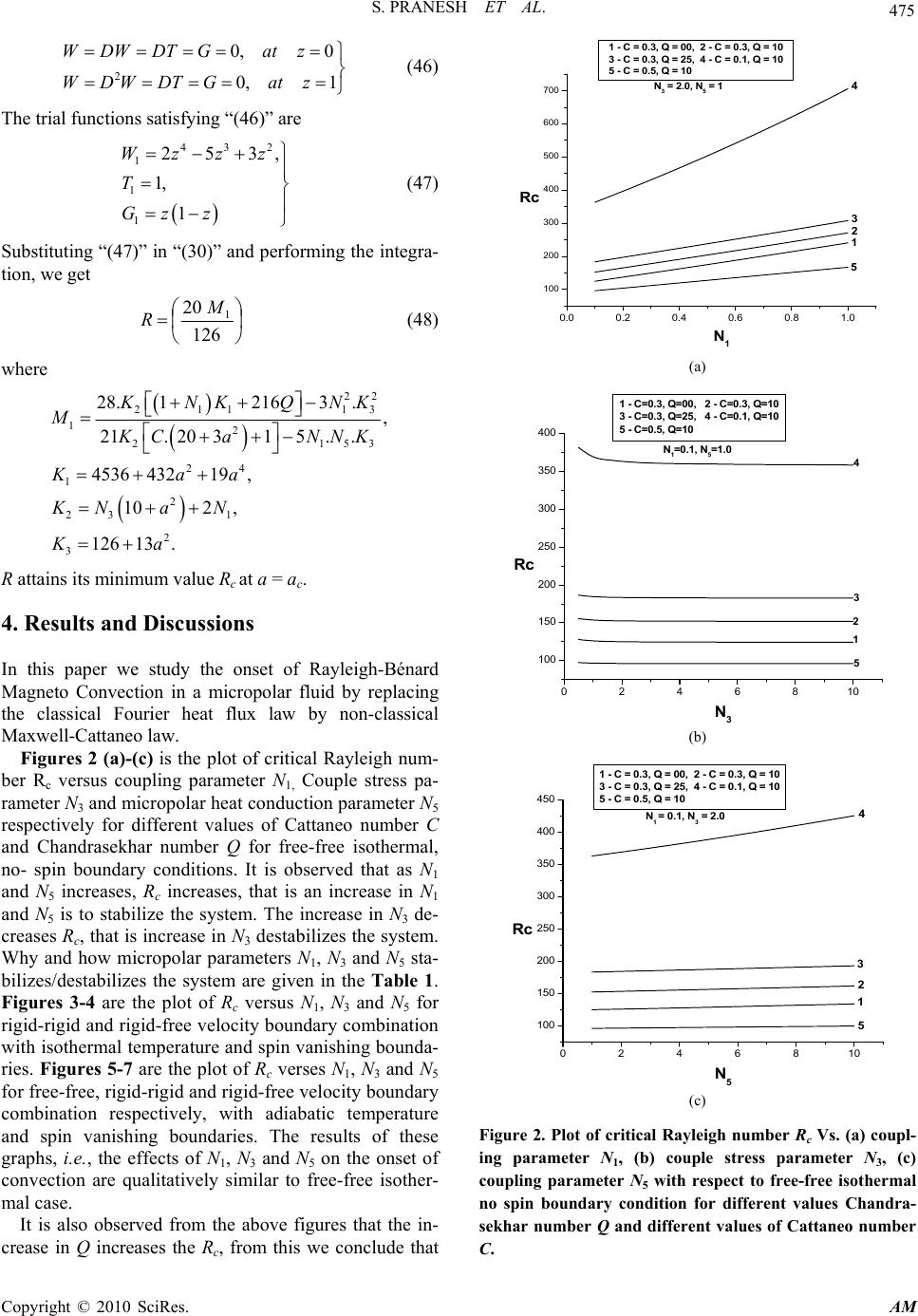 S. PRANESH ET AL. Copyright © 2010 SciRes. AM 475 1,0 0,0 2zatGDTWDW zatGDTDWW (46) The trial functions satisfying “(46)” are 432 1 1 1 253, 1, 1 Wzzz T Gz z (47) Substituting “(47)” in “(30)” and performing the integra- tion, we get 126 20 1 M R (48) where 22 21113 12 2153 24 1 2 23 1 2 3 28.12163 ., 21. 20315.. 4536 43219, 102 , 126 13. K NKQNK M K Ca NNK Kaa KNa N Ka R attains its minimum value Rc at a = ac. 4. Results and Discussions In this paper we study the onset of Rayleigh-Bénard Magneto Convection in a micropolar fluid by replacing the classical Fourier heat flux law by non-classical Maxwell-Cattaneo law. Figures 2 (a)-(c) is the plot of critical Rayleigh num- ber Rc versus coupling parameter N1, Couple stress pa- rameter N3 and micropolar heat conduction parameter N5 respectively for different values of Cattaneo number C and Chandrasekhar number Q for free-free isothermal, no- spin boundary conditions. It is observed that as N1 and N5 increases, Rc increases, that is an increase in N1 and N5 is to stabilize the system. The increase in N3 de- creases Rc, that is increase in N3 destabilizes the system. Why and how micropolar parameters N1, N3 and N5 sta- bilizes/destabilizes the system are given in the Table 1. Figures 3-4 are the plot of Rc versus N1, N3 and N5 for rigid-rigid and rigid-free velocity boundary combination with isothermal temperature and spin vanishing bounda- ries. Figures 5-7 are the plot of Rc verses N1, N3 and N5 for free-free, rigid-rigid and rigid-free velocity boundary combination respectively, with adiabatic temperature and spin vanishing boundaries. The results of these graphs, i.e. , the effects of N1, N3 and N5 on the onset of convection are qualitatively similar to free-free isother- mal case. It is also observed from the above figures that the in- crease in Q increases the Rc, from this we conclude that 0.0 0.20.4 0.6 0.8 1.0 100 200 300 400 500 600 700 N 3 = 2.0, N 5 = 1 1 - C = 0.3, Q = 00, 2 - C = 0.3, Q = 1 0 3 - C = 0.3, Q = 25, 4 - C = 0.1, Q = 1 0 5 - C = 0.5, Q = 10 5 4 3 2 1 Rc N 1 (a) 0246810 100 150 200 250 300 350 400 N 1 =0.1, N 5 =1.0 1 - C=0.3, Q=00, 2 - C =0.3, Q =10 3 - C=0.3, Q=25, 4 - C =0.1, Q =10 5 - C=0.5, Q=10 5 4 2 3 1 Rc N 3 (b) 0246810 100 150 200 250 300 350 400 450 N 1 = 0.1, N 3 = 2.0 5 4 3 2 1 1 - C = 0.3, Q = 00, 2 - C = 0.3, Q = 10 3 - C = 0.3, Q = 25, 4 - C = 0.1, Q = 10 5 - C = 0.5, Q = 10 Rc N 5 (c) Figure 2. Plot of critical Rayleigh number Rc Vs. (a) coupl- ing parameter N1, (b) couple stress parameter N3, (c) coupling parameter N5 with respect to free-free isothermal no spin boundary condition for different values Chandra- sekhar number Q and different values of Cattaneo number C. 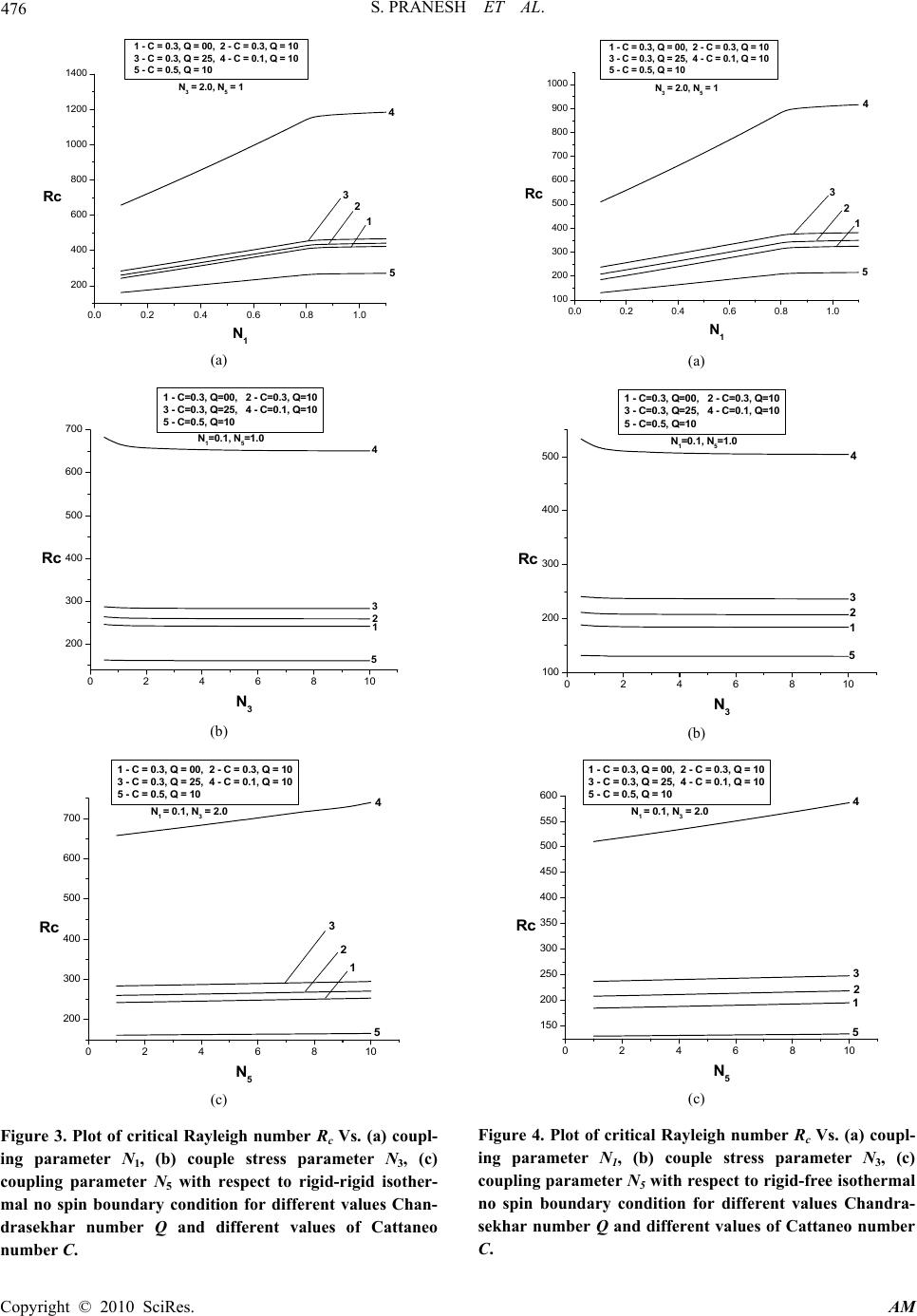 S. PRANESH ET AL. Copyright © 2010 SciRes. AM 476 0.0 0.2 0.4 0.6 0.8 1.0 200 400 600 800 1000 1200 1400 N 3 = 2.0, N 5 = 1 1 - C = 0.3, Q = 00, 2 - C = 0 .3, Q = 10 3 - C = 0.3, Q = 25, 4 - C = 0 .1, Q = 10 5 - C = 0.5, Q = 10 5 4 1 2 3 Rc N 1 (a) 0246810 200 300 400 500 600 700 1 - C=0.3, Q=00, 2 - C=0.3, Q=10 3 - C=0.3, Q=25, 4 - C=0.1, Q=10 5 - C=0.5, Q=10 N 1 =0.1, N 5 =1.0 5 4 3 2 1 Rc N 3 (b) 0246810 200 300 400 500 600 700 N 1 = 0.1, N 3 = 2.0 1 - C = 0.3, Q = 00, 2 - C = 0.3, Q = 1 0 3 - C = 0.3, Q = 25, 4 - C = 0.1, Q = 1 0 5 - C = 0.5, Q = 10 5 4 3 2 1 Rc N 5 (c) Figure 3. Plot of critical Rayleigh number Rc Vs. (a) coupl- ing parameter N1, (b) couple stress parameter N3, (c) coupling parameter N5 with respect to rigid-rigid isother- mal no spin boundary condition for different values Chan- drasekhar number Q and different values of Cattaneo number C. 0.00.20.40.60.81.0 100 200 300 400 500 600 700 800 900 1000 N 3 = 2.0, N 5 = 1 1 - C = 0.3, Q = 00 , 2 - C = 0. 3, Q = 10 3 - C = 0.3, Q = 25 , 4 - C = 0. 1, Q = 10 5 - C = 0.5, Q = 10 5 4 3 2 1 Rc N 1 (a) 0246810 100 200 300 400 500 N 1 =0.1, N 5 =1.0 1 - C=0.3, Q=00, 2 - C=0.3, Q=10 3 - C=0.3, Q=25, 4 - C=0.1, Q=10 5 - C=0.5, Q=10 5 4 3 2 1 Rc N 3 (b) 0246810 150 200 250 300 350 400 450 500 550 600 N 1 = 0.1, N 3 = 2.0 1 - C = 0.3, Q = 00, 2 - C = 0.3, Q = 10 3 - C = 0.3, Q = 25, 4 - C = 0.1, Q = 10 5 - C = 0.5, Q = 10 5 4 3 2 1 Rc N 5 (c) Figure 4. Plot of critical Rayleigh number Rc Vs. (a) coupl- ing parameter N1, (b) couple stress parameter N3, (c) coupling parameter N5 with respect to rigid-free isothermal no spin boundary condition for different values Chandra- sekhar number Q and different values of Cattaneo number C. 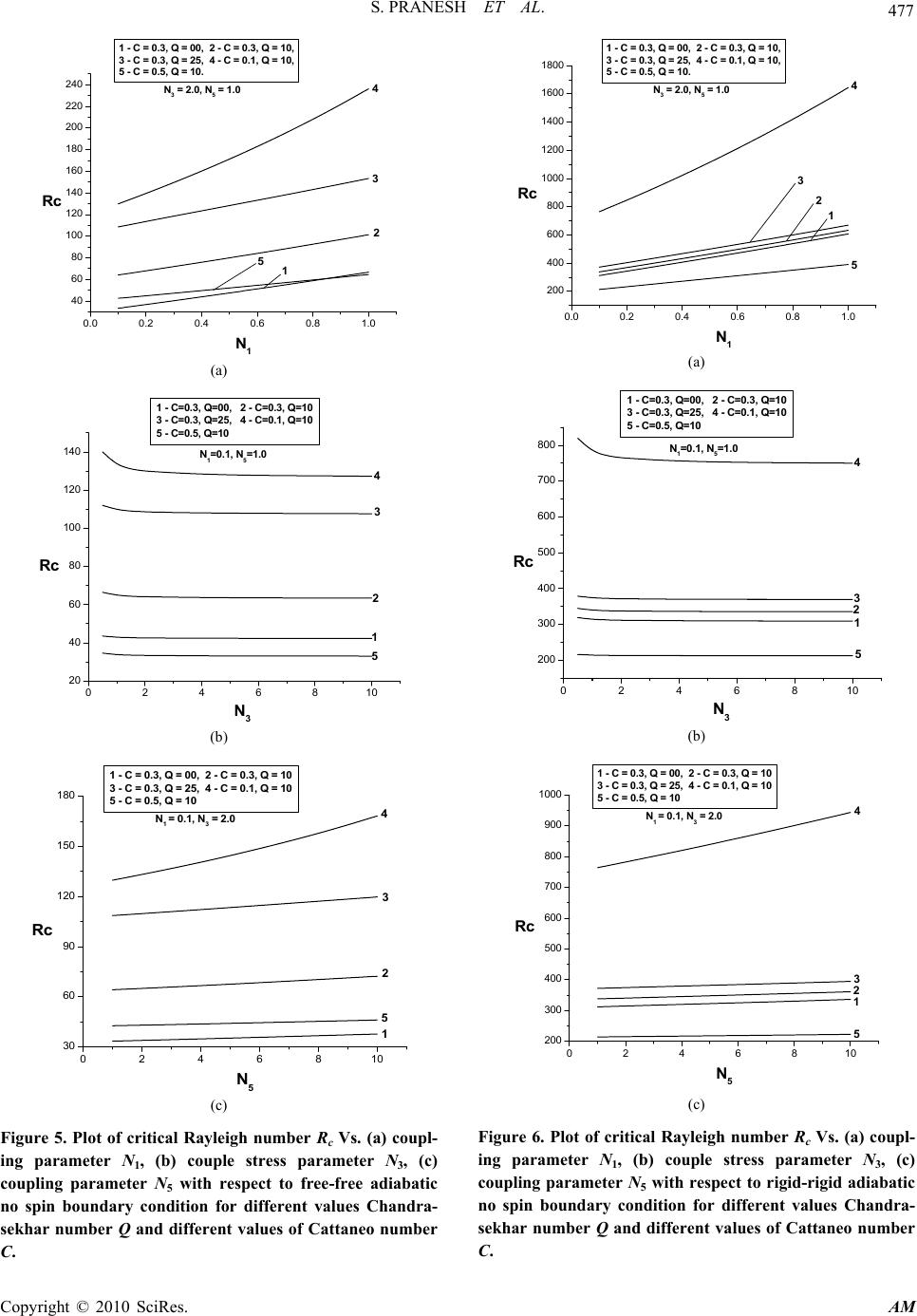 S. PRANESH ET AL. Copyright © 2010 SciRes. AM 477 0.0 0.2 0.4 0.6 0.8 1.0 40 60 80 100 120 140 160 180 200 220 240 5 4 3 2 1 N 3 = 2.0, N 5 = 1.0 1 - C = 0.3, Q = 00, 2 - C = 0.3, Q = 10, 3 - C = 0.3, Q = 25, 4 - C = 0.1, Q = 10, 5 - C = 0.5, Q = 10. Rc N 1 (a) 0246810 20 40 60 80 100 120 140 5 4 3 2 1 N 1 =0.1 , N 5 =1.0 1 - C=0.3, Q=00, 2 - C=0.3, Q=10 3 - C=0.3, Q=25, 4 - C=0.1, Q=10 5 - C=0.5, Q=10 N 3 Rc (b) 0246810 30 60 90 120 150 180 1 - C = 0.3, Q = 00, 2 - C = 0.3, Q = 10 3 - C = 0.3, Q = 25, 4 - C = 0.1, Q = 10 5 - C = 0.5, Q = 10 N1 = 0.1, N3 = 2.0 5 4 3 2 1 Rc N 5 (c) Figure 5. Plot of critical Rayleigh number Rc Vs. (a) coupl- ing parameter N1, (b) couple stress parameter N3, (c) coupling parameter N5 with respect to free-free adiabatic no spin boundary condition for different values Chandra- sekhar number Q and different values of Cattaneo number C. 0.0 0.20.4 0.60.8 1.0 200 400 600 800 1000 1200 1400 1600 1800 N3 = 2.0, N 5 = 1.0 1 - C = 0.3 , Q = 00 , 2 - C = 0 .3, Q = 10, 3 - C = 0.3 , Q = 25 , 4 - C = 0 .1, Q = 10, 5 - C = 0.5 , Q = 10 . 5 4 3 21 Rc N 1 (a) 0246810 200 300 400 500 600 700 800 N 1 =0.1, N 5 =1.0 1 - C=0.3, Q=00, 2 - C =0.3, Q =10 3 - C=0.3, Q=25, 4 - C =0.1, Q =10 5 - C=0.5, Q=10 4 5 3 2 1 N3 Rc (b) 0246810 200 300 400 500 600 700 800 900 1000 N 1 = 0.1, N 3 = 2.0 1 - C = 0.3, Q = 00, 2 - C = 0.3, Q = 10 3 - C = 0.3, Q = 25, 4 - C = 0.1, Q = 10 5 - C = 0.5, Q = 10 5 4 3 2 1 Rc N 5 (c) Figure 6. Plot of critical Rayleigh number Rc Vs. (a) coupl- ing parameter N1, (b) couple stress parameter N3, (c) coupling parameter N5 with respect to rigid-rigid adiabatic no spin boundary condition for different values Chandra- sekhar number Q and different values of Cattaneo number C. 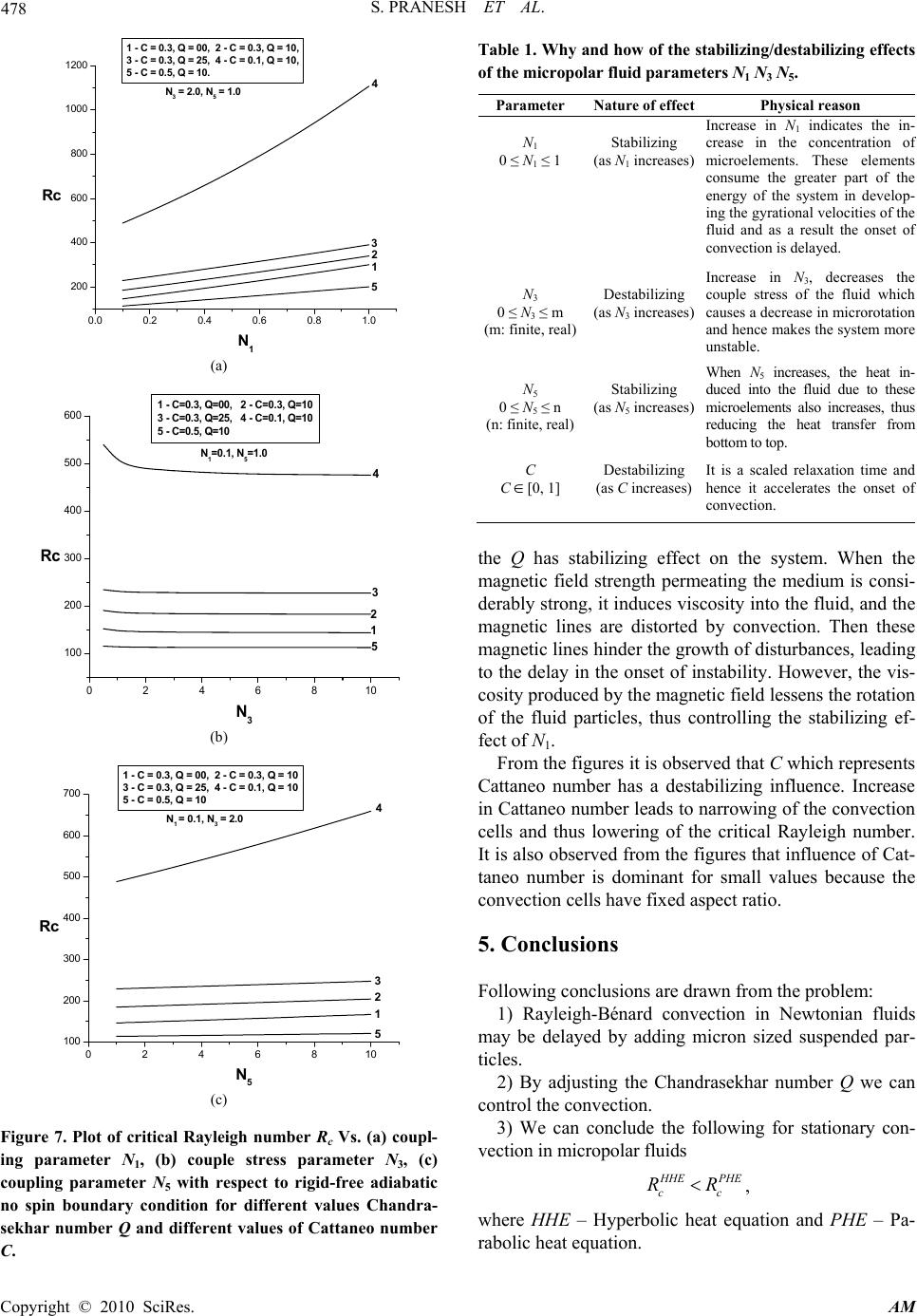 S. PRANESH ET AL. Copyright © 2010 SciRes. AM 478 0.0 0.2 0.4 0.6 0.8 1.0 200 400 600 800 1000 1200 5 4 3 2 1 N 3 = 2.0, N 5 = 1.0 1 - C = 0.3, Q = 00, 2 - C = 0.3, Q = 10, 3 - C = 0.3, Q = 25, 4 - C = 0.1, Q = 10, 5 - C = 0.5, Q = 10. Rc N 1 (a) 0246810 100 200 300 400 500 600 N 1 =0.1, N 5 =1.0 1 - C=0.3, Q=00, 2 - C=0.3, Q=10 3 - C=0.3, Q=25, 4 - C=0.1, Q=10 5 - C=0.5, Q=10 5 4 3 2 1 Rc N 3 (b) 0246810 100 200 300 400 500 600 700 N 1 = 0.1, N 3 = 2.0 1 - C = 0.3, Q = 00, 2 - C = 0.3, Q = 10 3 - C = 0.3, Q = 25, 4 - C = 0.1, Q = 10 5 - C = 0.5, Q = 10 5 4 3 2 1 Rc N 5 (c) Figure 7. Plot of critical Rayleigh number Rc Vs. (a) coupl- ing parameter N1, (b) couple stress parameter N3, (c) coupling parameter N5 with respect to rigid-free adiabatic no spin boundary condition for different values Chandra- sekhar number Q and different values of Cattaneo number C. Table 1. Why and how of the stabilizing/destabilizing effects of the micropolar fluid parameters N1 N3 N 5. Parameter Nature of effect Physical reason N1 0 ≤ N1 ≤ 1 Stabilizing (as N1 increases) Increase in N1 indicates the in- crease in the concentration o f microelements. These elements consume the greater part of the energy of the system in develop- ing the gyrational velocities of the fluid and as a result the onset o f convection is delayed. N3 0 ≤ N3 ≤ m (m: finite, real) Destabilizing (as N3 increases) Increase in N3, decreases the couple stress of the fluid which causes a decrease in microrotation and hence makes the system more unstable. N5 0 ≤ N5 ≤ n (n: finite, real) Stabilizing (as N5 increases) When N5 increases, the heat in- duced into the fluid due to these microelements also increases, thus reducing the heat transfer fro m bottom to top. C C [0, 1] Destabilizing (as C increases) It is a scaled relaxation time and hence it accelerates the onset o f convection. the Q has stabilizing effect on the system. When the magnetic field strength permeating the medium is consi- derably strong, it induces viscosity into the fluid, and the magnetic lines are distorted by convection. Then these magnetic lines hinder the growth of disturbances, leading to the delay in the onset of instability. However, the vis- cosity produced by the magnetic field lessens the rotation of the fluid particles, thus controlling the stabilizing ef- fect of N1. From the figures it is observed that C which represents Cattaneo number has a destabilizing influence. Increase in Cattaneo number leads to narrowing of the convection cells and thus lowering of the critical Rayleigh number. It is also observed from the figures that influence of Cat- taneo number is dominant for small values because the convection cells have fixed aspect ratio. 5. Conclusions Following conclusions are drawn from the problem: 1) Rayleigh-Bénard convection in Newtonian fluids may be delayed by adding micron sized suspended par- ticles. 2) By adjusting the Chandrasekhar number Q we can control the convection. 3) We can conclude the following for stationary con- vection in micropolar fluids PHE c HHE cRR, where HHE – Hyperbolic heat equation and PHE – Pa- rabolic heat equation. 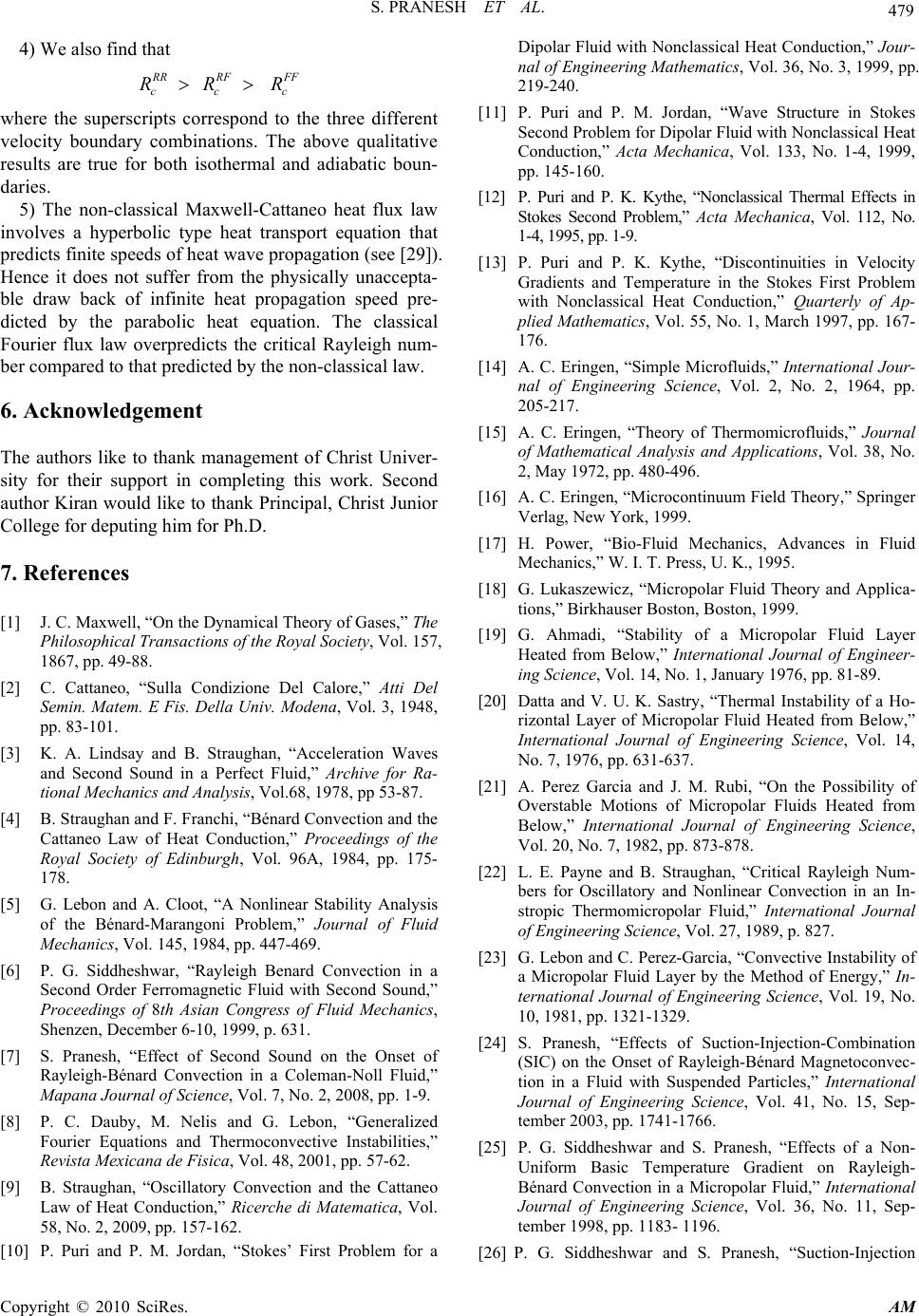 S. PRANESH ET AL. Copyright © 2010 SciRes. AM 479 4) We also find that FF c RF c RR cRRR where the superscripts correspond to the three different velocity boundary combinations. The above qualitative results are true for both isothermal and adiabatic boun- daries. 5) The non-classical Maxwell-Cattaneo heat flux law involves a hyperbolic type heat transport equation that predicts finite speeds of heat wave propagation (see [29]). Hence it does not suffer from the physically unaccepta- ble draw back of infinite heat propagation speed pre- dicted by the parabolic heat equation. The classical Fourier flux law overpredicts the critical Rayleigh num- ber compared to that predicted by the non-classical law. 6. Acknowledgement The authors like to thank management of Christ Univer- sity for their support in completing this work. Second author Kiran would like to thank Principal, Christ Junior College for deputing him for Ph.D. 7. References [1] J. C. Maxwell, “On the Dynamical Theory of Gases,” The Philosophical Transactions of the Royal Society, Vol. 157, 1867, pp. 49-88. [2] C. Cattaneo, “Sulla Condizione Del Calore,” Atti Del Semin. Matem. E Fis. Della Univ. Modena, Vol. 3, 1948, pp. 83-101. [3] K. A. Lindsay and B. Straughan, “Acceleration Waves and Second Sound in a Perfect Fluid,” Archive for Ra- tional Mechanics and Analysis, Vol.68, 1978, pp 53-87. [4] B. Straughan and F. Franchi, “Bénard Convection and the Cattaneo Law of Heat Conduction,” Proceedings of the Royal Society of Edinburgh, Vol. 96A, 1984, pp. 175- 178. [5] G. Lebon and A. Cloot, “A Nonlinear Stability Analysis of the Bénard-Marangoni Problem,” Journal of Fluid Mechanics, Vol. 145, 1984, pp. 447-469. [6] P. G. Siddheshwar, “Rayleigh Benard Convection in a Second Order Ferromagnetic Fluid with Second Sound,” Proceedings of 8th Asian Congress of Fluid Mechanics, Shenzen, December 6-10, 1999, p. 631. [7] S. Pranesh, “Effect of Second Sound on the Onset of Rayleigh-Bénard Convection in a Coleman-Noll Fluid,” Mapana Journal of Science, Vol. 7, No. 2, 2008, pp. 1-9. [8] P. C. Dauby, M. Nelis and G. Lebon, “Generalized Fourier Equations and Thermoconvective Instabilities,” Revista Mexicana de Fisica, Vol. 48, 2001, pp. 57-62. [9] B. Straughan, “Oscillatory Convection and the Cattaneo Law of Heat Conduction,” Ricerche di Matematica, Vol. 58, No. 2, 2009, pp. 157-162. [10] P. Puri and P. M. Jordan, “Stokes’ First Problem for a Dipolar Fluid with Nonclassical Heat Conduction,” Jour- nal of Engineering Mathematics, Vol. 36, No. 3, 1999, pp. 219-240. [11] P. Puri and P. M. Jordan, “Wave Structure in Stokes Second Problem for Dipolar Fluid with Nonclassical Heat Conduction,” Acta Mechanica, Vol. 133, No. 1-4, 1999, pp. 145-160. [12] P. Puri and P. K. Kythe, “Nonclassical Thermal Effects in Stokes Second Problem,” Acta Mechanica, Vol. 112, No. 1-4, 1995, pp. 1-9. [13] P. Puri and P. K. Kythe, “Discontinuities in Velocity Gradients and Temperature in the Stokes First Problem with Nonclassical Heat Conduction,” Quarterly of Ap- plied Mathematics, Vol. 55, No. 1, March 1997, pp. 167- 176. [14] A. C. Eringen, “Simple Microfluids,” International Jour- nal of Engineering Science, Vol. 2, No. 2, 1964, pp. 205-217. [15] A. C. Eringen, “Theory of Thermomicrofluids,” Journal of Mathematical Analysis and Applications, Vol. 38, No. 2, May 1972, pp. 480-496. [16] A. C. Eringen, “Microcontinuum Field Theory,” Springer Verlag, New York, 1999. [17] H. Power, “Bio-Fluid Mechanics, Advances in Fluid Mechanics,” W. I. T. Press, U. K., 1995. [18] G. Lukaszewicz, “Micropolar Fluid Theory and Applica- tions,” Birkhauser Boston, Boston, 1999. [19] G. Ahmadi, “Stability of a Micropolar Fluid Layer Heated from Below,” International Journal of Engineer- ing Science, Vol. 14, No. 1, January 1976, pp. 81-89. [20] Datta and V. U. K. Sastry, “Thermal Instability of a Ho- rizontal Layer of Micropolar Fluid Heated from Below,” International Journal of Engineering Science, Vol. 14, No. 7, 1976, pp. 631-637. [21] A. Perez Garcia and J. M. Rubi, “On the Possibility of Overstable Motions of Micropolar Fluids Heated from Below,” International Journal of Engineering Science, Vol. 20, No. 7, 1982, pp. 873-878. [22] L. E. Payne and B. Straughan, “Critical Rayleigh Num- bers for Oscillatory and Nonlinear Convection in an In- stropic Thermomicropolar Fluid,” International Journal of Engineering Science, Vol. 27, 1989, p. 827. [23] G. Lebon and C. Perez-Garcia, “Convective Instability of a Micropolar Fluid Layer by the Method of Energy,” In- ternational Journal of Engineering Science, Vol. 19, No. 10, 1981, pp. 1321-1329. [24] S. Pranesh, “Effects of Suction-Injection-Combination (SIC) on the Onset of Rayleigh-Bénard Magnetoconvec- tion in a Fluid with Suspended Particles,” International Journal of Engineering Science, Vol. 41, No. 15, Sep- tember 2003, pp. 1741-1766. [25] P. G. Siddheshwar and S. Pranesh, “Effects of a Non- Uniform Basic Temperature Gradient on Rayleigh- Bénard Convection in a Micropolar Fluid,” International Journal of Engineering Science, Vol. 36, No. 11, Sep- tember 1998, pp. 1183- 1196. [26] P. G. Siddheshwar and S. Pranesh, “Suction-Injection  S. PRANESH ET AL. Copyright © 2010 SciRes. AM 480 Effects on the Onset of Rayleigh-Bénard-Marangoni Convection in a Fluid with Suspended Particles,” Acta Mechanica, Vol. 152, No. 1-4, 2001, pp. 241-252. [27] P. G. Siddheshwar and S. Pranesh, “Magnetoconvection in Fluids with Suspended Particles under 1g and G,” In- ternational Journal of Aerospace Science and Technolo- gy, Vol. 6, No. 2, February 2001, pp. 105-114. [28] P. G. Siddheshwar and S. Pranesh, “Effect of Tempera- ture/Gravity Modulation on the Onset of Magneto Con- vection in Weak Electrically Conducting Fluids with In- ternal Angular Momentum,” Journal of Magnetism and Magnetic Materials, Vol. 192, No. 1, February 1999, pp. 159-176. [29] Lawrence C. Evans, “Partial Differential Equations (Schaum’s Outline Series),” Tata McGraw Hill, India, 2010. |

